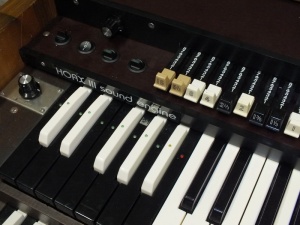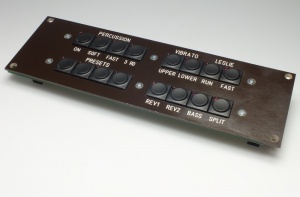HX3 Board User Manual
"Hammond on a Xilinx FPGA," HX3 single-board sound engine for connecting any keyboard, for installation into existing organs or MIDI control
Features
- Compact organ emulator module on single PCB, 200 x 100 mm, for OEM installation
- Authentic reproduction of generator, tapering, key contacts, percussion and vibrato by FPGA (Field Programmable Gate Array)
- Extremely low latency of 50 microseconds Key-to-Audio (not >20 ms as with other MIDI expanders and software emulation)
- Natural key click by "rattling" contacts
- Accurate Leslie simulation with separate outputs
- MIDI IN accepts 5 different MIDI CC sets
- Drawbar connection by 9 to 24 analog control voltages
- Connection for switches (active low) or digital switch control voltages (Percussion ON, Soft / Normal, 2nd/3rd, vibrato, vibrato ON upper/lower, chorus / vibrato)
- MIDI-in/out (accepts different MIDI CC sets)
- Connection of any type of keyboards (key contact to ground or matrix) with additional scan board (optional)
- New firmware 3.53 and up support HX3 Remote Application for Windows PCs, a convenient way to set up and tune your HX3 board
HX3 may also be used without any switches/drawbars/pots connected by selecting "Expander Mode" - see page Using HX3 with MIDI controllers. You may leave all internal connectors open if you plan to remote by MIDI only with analog control inputs disabled.
Jack Connections
The HX3 module has two 1/4" audio output jacks, one DC input jack and two accessory jacks. Signals are also availabe on 3-pin headers mounted on PCB.
- AUDIO 1/2: Audio output jacks are configurable by menu. Two custom settings A and B are available, each to be configured separately. On default, the two audio jacks carry Leslie stereo signal on config A and organ/pedal on plug rings on config B. Be shure to switch to plain organ or Amp122 output when using an external Leslie or -simulator. Set JP6 to 2-CHANNEL (opposite to MONO) on older HX3 mk2 boards when using stereo Leslie simulation. Leslie amp simulation is 122 amp without speakers, but with overdrive capabilities. Output level is 300 mV (full "Leslie Volume"). The amp signal may be used with transistor leslies to obtain the nice tube overdrive effect provided by HX3. On higher "Leslie Volume" levels, you will notice the tube overdrive/distortion of simulated 6550 output stage.
- SWELL: Expression pedal input is compatible with Yamaha FC-7 and similar expression pedals (direct connection preferred for speed/accuracy, but may also be remoted by MIDI CC 11).
- FOOTSW: Single or double footswich controls simulated Leslie speed as well as Leslie I/F control bits (pin 1 to 4 on HX3 PL12): SLOW/FAST on plug tip, RUN/STOP on plug ring. Please use latching foot switches; momentary (button type) switches are not supported. If single footswitch used, Leslie is always on RUN (no plug ring, input grouded by plug sleeve).
- DC IN: Use stabilized DC wall wart 9 to 12V with at least 800mA current output, inner/outer plug diameter 2.1/5.5 mm on DC input jack. Regard jumper setting of JP12 (see below - must be removed for 9 to 12V voltages). Alternatively, use stabilized DC wall wart 5V/1A with jumper JP12 installed or use internal 5V power connector PL2.
Jumper Settings
Only jumpers JP6 and JP12 are relevant for users; all others should be removed during normal operation. You may use JP11 and JP10 (ground test connections) as a jumper "rest" for unused jumpers.
2-way jumper JP6 sets MAIN/BASS output jack either to MONO or to 2-channel output (separate pedal bass on plug ring). See "Jack Connections" (above) for details. Set JP6 to 2-CHANNEL (opposite to MONO) when using stereo Leslie simulation. JP12 disables internal 5V voltage regulator U21 for use with 5V power supplies on DC jack PL27. Remove JP12 if using 9 to 12V power on DC jack.
JP5 has to be inserted on re-configuring/updating the FPGA (HX3 sound engine). JP7 and JP8 have to be inserted for Reverb DSP updates (along with FPGA update). See page Firmware- und FPGA-Update for details.
MIDI Control
HX3 expander accepts MIDI key on/off events (default: channel 1 to upper manual, 2 to lower manual, channel 3 to bass pedals) as well as various MIDI CCs with selectable compatibility sets. Please see page Using HX3 with MIDI controllers for details. SysEx data is always ignored. MIDI OUT acts as a MIDI TRHU output on HX3 expander, as no internal key events are transmitted.
Menu System
If using an optional MenuPanel, see HX3 MenuPanel user manual for menu system description. Note: Some entries only apply to expander use (i.e. analog enables for drawbars/pots etc.).
Volume Control
Organ's volume is controlled by an expression pedal or MIDI CC #11 (may also be another CC number on various MIDI CC sets to retain compatibility). HX3 resembles a "loudness" curve exact of Hammond B3's swell pedal, so volume will not reach zero.
We recommend connecting an expression pedal Yamaha FC-7 or similar (1/4" jack, 10k to 47k total resistance) directly to the module, as it has a higher resolution and acts faster than MIDI control by MIDI CC #11. Anyway, instead of the ORGAN MAIN output you may use the simulated Leslie Amp 122 output instead which has a separate volume pot (for example by MIDI CC $4C hex, 76 decimal in NI B4 MIDI CC set). It may be also be changed by MenuPanel entry "LeslieVolume" (to be reached directly by pressing DATA ENTRY knob after power-on).
Note: On firmware up to version #3.44, despite the swell/expression pedal (or MIDI CC #11) there is a "simulated" total volume control by MIDI CC #7. But: It only reduces "travel" of swell pedal, it is not intended as a volume pot substitute (would reduce resolution and S/N ratio due to internal 16 bit audio handling). On firmware #3.45 and newer, MIDI CC #7 controls the Leslie amp volume which only affects the LESL/AMP Leslie Sim and Leslie Amp output jack.
Drawbars
Drawbars will react exactly as on real B3 organ in "live" presets (preset numbers 0 and 15). Switching from preset 1 to 14 to "live" will update drawbar setting immediately to actual positions. Any preset may be changed "on the fly" by changing the desired drawbar or tab/vibrato control (and may be saved with new sound afterwards). On installations with Preset24 board, please note which drawbar set (two per manual) is active.
User Panel
When using LED buttons, pressing the push button (momentary contact, using HX3 PL7 and PL11) toggles on and off, which is indicated by the LED. If using optional Panel16 board instead of separate switches, function layout is as follows:
| Perc ON | Perc SOFT | Perc FAST | Perc THIRD | Vib ON upper | Vib ON lower | Leslie RUN | Leslie FAST | |
| Preset 1 | Preset 2 | Preset 3 | Preset 4 | Reverb I | Reverb II | BassOnLeslie | Split ON |
Same functions can be obtained with rocker tab switches (using HX3 PL8 and PL12), dependant on your installation.
Reverb/BassOnLeslie
There are four reverb levels available: OFF, REV 1, REV 2, REV 1 + 2. Another switch/button determines whether the bass signal from the pedal is sent (internally) to Leslie sim/amp out or not. The pedal signal is otherwise available only on the organ output (see above) for separate amplification.
Split Function
Only valid for HX3 with scan cores from Rev. #21 and up: Keyboard split can now be done with a selectable split point and also on the lower or upper manual - as some clones only have one manual.
- Press the button of the desired split point on the lower manual, hold while turning Split on: Pedal to lower manual below note pressed. Or:
- Press the button of the desired split point on upper manual, hold while turning Split on: Lower to upper manual below note pressed. Lower manual is now turned off. Or:
- Press two buttons side by side on upper manual, hold while turning Split on: Pedal to upper manual below notes pressed. Pedal is now off.
- Press three adjacent buttons on upper manual, hold while turning Split on: Lower +1 octave to upper manual below highest note pressed.
- Press four adjacent buttons on upper manual, hold while turning Split on: Lower +2 octave to upper manual below highest note pressed.
Split setting will remain even after switching off and switching on the split function without holding a key, but only until power-off.
Presets
The four common presets (for upper and lower manual at the same time) work as follows: If none of the four LEDs is lit, the "live" setting is selected, drawbars and tabs switch or buttons are active. When pressing one of the preset buttons the corresponding preset is called, another press on the same button switches the preset off again (ie. back to "live" setting). If the button is held for more than two seconds, the last accessed setting is stored here. You may save the "live" setting (ie. previously no preset LED lit) as well as another preset (one other Preset LED lit, so you can copy from one to another preset). The saving procedure is signaled by short flickering of all Preset LEDs.
Coding of common presets is binary, they will call manual presets 1, 2, 4 and 8 (preset 0 is "Live"). It is allowed to press more than one common preset button simultaneously. Upcoming firmware version 3.925 will make it easier to select binary coded presets.
7, 10 or 15 presets separate for each manual are available with supplementary boards Preset16 (one or two, ie. 7 or 15 presets per manual) and Preset24 (10 presets per manual), the latter with switching from two drawbar "live" sets per manual as on real B3. As on common presets, a preset will be saved by pressing a preset button or Preset24 key by more than 2 seconds. See Preset16 and Preset24 pages for details.
Presets may be edited by simply altering the tab, drawbar or pot to be changed. Altered presets may be saved again, also on different preset number.
Preset Behaviour on HX3 MIDI Expander
On HX3 MIDI Expander, all tabs are saved to presets; preset 0 is a special "live" preset that remembers sound changes by MIDI if temporarily switched to a preset other than 0. So you get your previous "live" sound back when you switch from other preset to 0 without having to "save". The "live" setting is held in RAM, so it is lost when powering off. However, it will remember that sound permanently if preset 0 is saved explicitely.
Preset Behaviour on HX3 Boards
On bare HX3 boards for organ installation, drawbars and tabs are always saved to 4 common presets found on Panel16. Tabs and vibrato knob setting are not saved to upper/lower presets, just the drawbars. Parameter 485 in HX3 Remote determines if tabs and vibrato are saved to each upper/lower preset or not.

